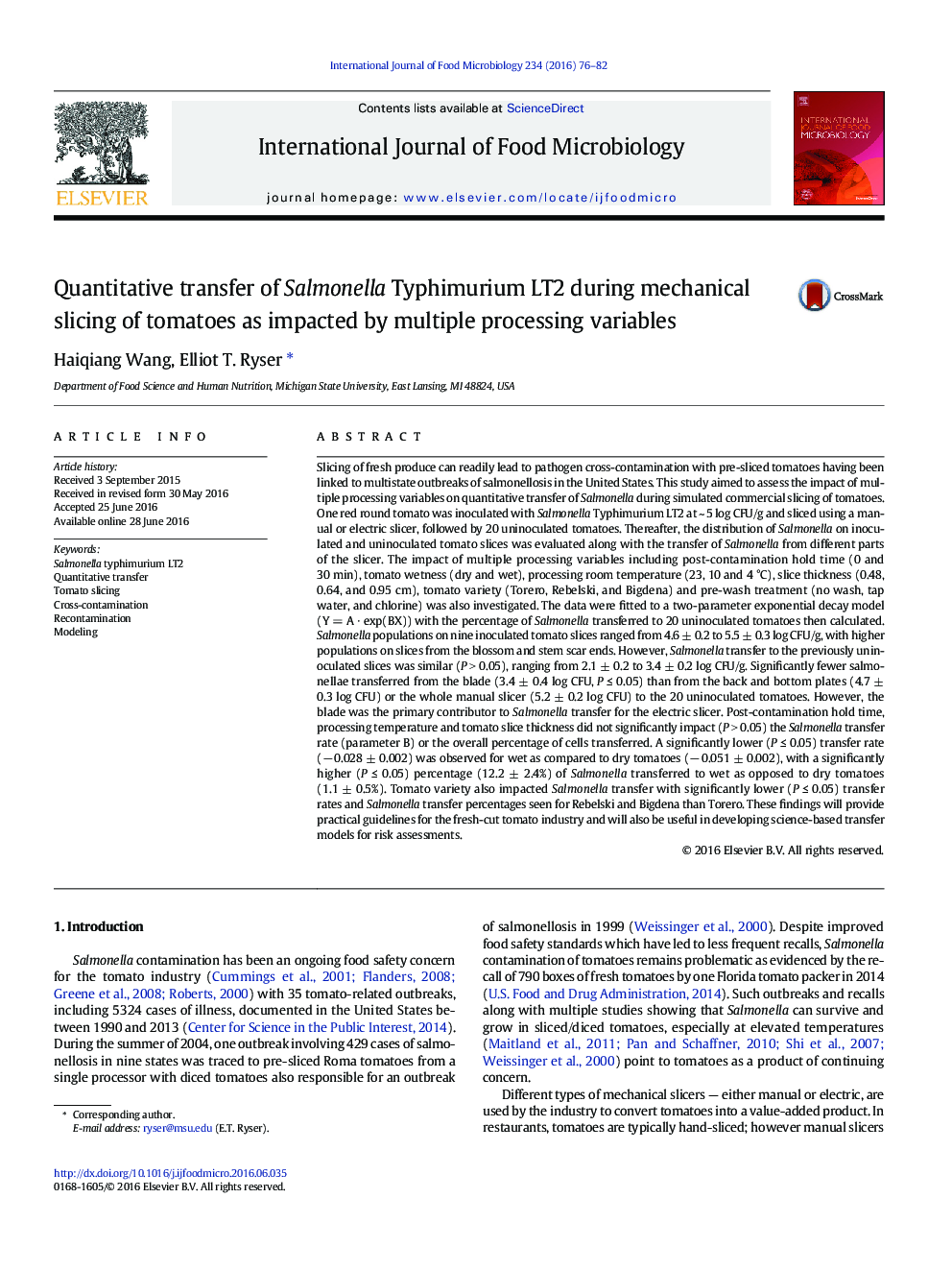| کد مقاله | کد نشریه | سال انتشار | مقاله انگلیسی | نسخه تمام متن |
|---|---|---|---|---|
| 4366199 | 1616549 | 2016 | 7 صفحه PDF | دانلود رایگان |

• Salmonella transfer followed an exponential decay model.
• The back & bottom plates were the primary contributors to Salmonella transfer.
• Tomato surface wetness and variety significantly affected Salmonella transfer.
Slicing of fresh produce can readily lead to pathogen cross-contamination with pre-sliced tomatoes having been linked to multistate outbreaks of salmonellosis in the United States. This study aimed to assess the impact of multiple processing variables on quantitative transfer of Salmonella during simulated commercial slicing of tomatoes. One red round tomato was inoculated with Salmonella Typhimurium LT2 at ~ 5 log CFU/g and sliced using a manual or electric slicer, followed by 20 uninoculated tomatoes. Thereafter, the distribution of Salmonella on inoculated and uninoculated tomato slices was evaluated along with the transfer of Salmonella from different parts of the slicer. The impact of multiple processing variables including post-contamination hold time (0 and 30 min), tomato wetness (dry and wet), processing room temperature (23, 10 and 4 °C), slice thickness (0.48, 0.64, and 0.95 cm), tomato variety (Torero, Rebelski, and Bigdena) and pre-wash treatment (no wash, tap water, and chlorine) was also investigated. The data were fitted to a two-parameter exponential decay model (Y = A ⋅ exp(BX)) with the percentage of Salmonella transferred to 20 uninoculated tomatoes then calculated. Salmonella populations on nine inoculated tomato slices ranged from 4.6 ± 0.2 to 5.5 ± 0.3 log CFU/g, with higher populations on slices from the blossom and stem scar ends. However, Salmonella transfer to the previously uninoculated slices was similar (P > 0.05), ranging from 2.1 ± 0.2 to 3.4 ± 0.2 log CFU/g. Significantly fewer salmonellae transferred from the blade (3.4 ± 0.4 log CFU, P ≤ 0.05) than from the back and bottom plates (4.7 ± 0.3 log CFU) or the whole manual slicer (5.2 ± 0.2 log CFU) to the 20 uninoculated tomatoes. However, the blade was the primary contributor to Salmonella transfer for the electric slicer. Post-contamination hold time, processing temperature and tomato slice thickness did not significantly impact (P > 0.05) the Salmonella transfer rate (parameter B) or the overall percentage of cells transferred. A significantly lower (P ≤ 0.05) transfer rate (− 0.028 ± 0.002) was observed for wet as compared to dry tomatoes (− 0.051 ± 0.002), with a significantly higher (P ≤ 0.05) percentage (12.2 ± 2.4%) of Salmonella transferred to wet as opposed to dry tomatoes (1.1 ± 0.5%). Tomato variety also impacted Salmonella transfer with significantly lower (P ≤ 0.05) transfer rates and Salmonella transfer percentages seen for Rebelski and Bigdena than Torero. These findings will provide practical guidelines for the fresh-cut tomato industry and will also be useful in developing science-based transfer models for risk assessments.
Journal: International Journal of Food Microbiology - Volume 234, 3 October 2016, Pages 76–82